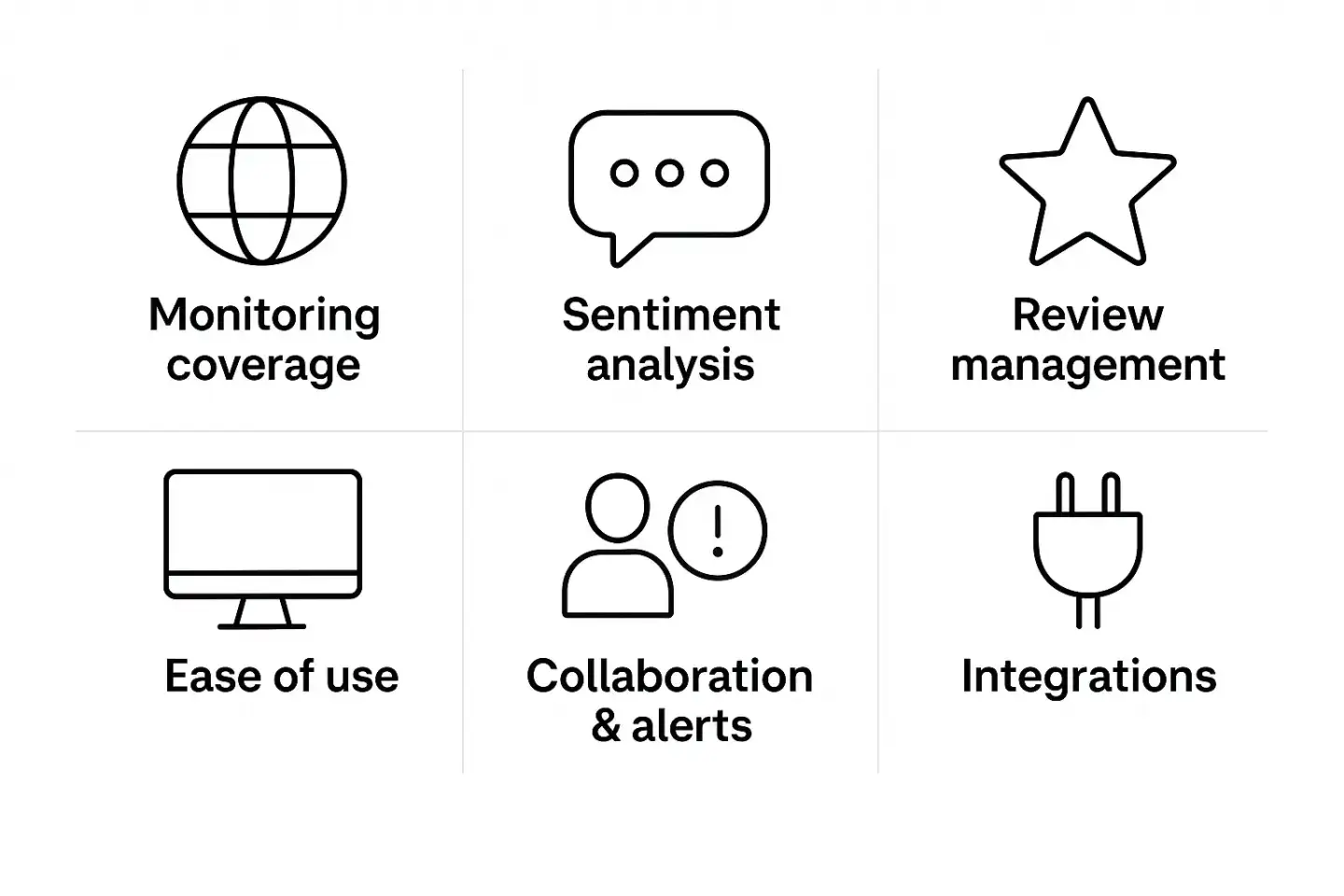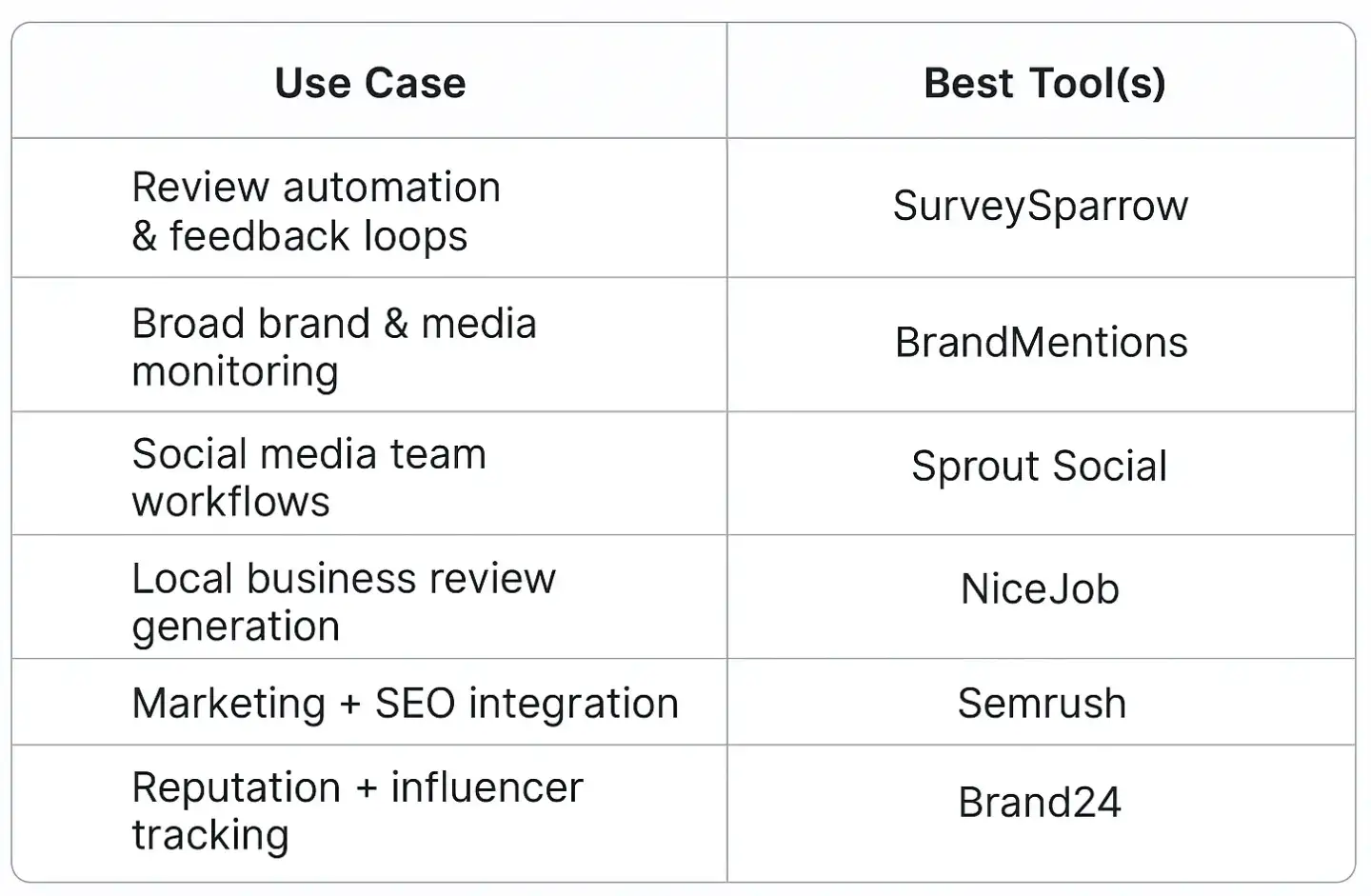We test and review software products using an independent, multipoint methodology. If you purchase something through our links, we may earn a commission. Read about our editorial process.
In the digital world, your brand’s reputation isn’t just built by your marketing team—it’s shaped by every tweet, review, article, and comment about your business, including online mentions of your digital presence. Managing that reputation requires more than checking your brand name in Google. In 2025, online reputation management (ORM) tools offer real-time monitoring, sentiment analysis, social customer service, review generation, and reporting to ensure you’re not just aware of your brand image—but in control of it.
Whether you’re a local business, a growing SaaS brand, or an international enterprise, the right ORM tool can help protect your credibility, respond faster to feedback, and build long-term trust. In this guide, we explore the best tools available today, based on performance, ease of use, feature set, and ability to turn insight into action.
Reputation is no longer a passive asset—it’s a live reflection of how potential customers perceive your business. In an era where a single negative review can influence thousands, or where viral backlash can damage hard-won trust, being proactive is crucial.
ORM tools empower you to:
Monitor mentions across news, blogs, social media, and review platforms to gain actionable insights.
Understand public sentiment toward your brand and competitors
Track ratings and reviews from Google, Yelp, Trustpilot, and more
Automate review requests and customer feedback loops
Respond quickly to crises or negative press
Highlight positive feedback to reinforce trust
Reputation is earned—but with the right tools, it’s also manageable.
To identify the top ORM tools of 2025, we applied our internal framework, which emphasizes the following:

Monitoring coverage: How wide is the tool’s listening net (social, forums, review sites, blogs, news)?
Sentiment analysis: Does it accurately classify mentions as positive, neutral, or negative?
Review management: Can it collect, respond to, and generate reviews automatically?
Ease of use: Is the interface intuitive and accessible to non-technical users?
Collaboration & alerts: Can teams share dashboards, assign tasks, and receive alerts?
Integration: Does it work well with your CRM, helpdesk, or marketing tools?
Now let’s explore the top solutions.
SurveySparrow is best known for its feedback and survey platform, but it also includes a powerful reputation management suite that features email campaigns. It focuses on collecting customer feedback, generating online reviews, and routing unhappy respondents for private resolution before they leave public criticism.
The tool’s strength lies in its automation for online review management. You can create workflows to trigger customer review requests after a purchase or service, and segment feedback based on satisfaction scores. It’s especially useful for brands looking to improve their ratings on Google, G2, or Yelp by identifying promoters and nudging them to post reviews or share social media content.
Best for: Businesses focused on review generation and improving customer feedback loops.
BrandMentions delivers real-time brand monitoring and social media monitoring across social platforms, blogs, forums, and the web. Its brand reputation monitoring tools allow you to track not only your brand but also competitors, keywords, and campaigns—all in one place.
Its sentiment detection is solid, and it allows deep analysis of mention volume, influence, and reach. What makes BrandMentions stand out is its ability to identify brand advocates and potential PR threats early, allowing your team to act quickly. Additionally, BrandMentions offers a free trial to explore these unique capabilities.
Best for: Digital marketers and PR professionals seeking broad visibility into online conversations.
Sprout Social is a full-featured social media management tool with built-in ORM capabilities. Its unified inbox, monitoring dashboard, and reporting make it easy to track brand mentions and customer conversations across platforms like Twitter, Facebook, Instagram, and LinkedIn.
It includes sentiment tracking, audience engagement metrics, and automated workflows for assigning responses to team members. For companies with active social profiles, Sprout Social centralizes reputation oversight into a single dashboard.
Best for: Brands managing multiple social channels who need team-based response workflows.
NiceJob is designed to help businesses generate and manage reviews, especially for local services, franchises, and small businesses. Its automation engine sends personalized review requests to recent customers, increasing the likelihood of positive feedback.
It integrates with booking, CRM, and POS systems to ensure the right timing. Additionally, it provides widgets and review displays you can embed on your website or social profiles to showcase credibility.
Best for: Local businesses and service providers who want to grow and display their online reviews.
Semrush offers reputation monitoring as part of its broader social media and content suite. It enables businesses to track mentions of their brand, products, or competitors on major platforms and assess overall sentiment over time, as well as review performance at individual locations.
What makes Semrush valuable is its integration with SEO, PPC, and competitive analysis tools—letting marketers understand how brand perception aligns with visibility, traffic, and performance.
Best for: Marketing teams already using Semrush for SEO or content analytics, who want to expand into reputation tracking.
Brand24 is a well-known name in reputation management and social listening. It monitors blogs, news, social media, video platforms, and forums, providing real-time alerts and deep analytics on brand sentiment.
Its UI is beginner-friendly, and it includes influencer identification, historical data, and crisis alerts. For teams managing PR risk, product feedback, or influencer campaigns, Brand24 offers robust features at a mid-range price point.
Best for: Teams needing a balance between broad monitoring and accessible UX.
Vendasta offers a full suite of white-label reputation management tools designed for agencies and resellers. It includes review tracking across various review websites, automated alerts, sentiment reporting, and competitor analysis—plus the ability to manage hundreds of local listings from a single platform.
One unique feature is its local citation management, which ensures your brand’s contact information is accurate across directories. This helps support both local SEO and reputation simultaneously.
Best for: Agencies managing reputation for multiple clients or locations.
Online reputation is fragile—and managing it requires vigilance, speed, and the right tools for online reputation management across social networks to enhance your online presence. While no platform can prevent bad reviews or viral crises, the best ORM tools give you the visibility, control, and insight to navigate them.

To summarize:
SurveySparrow is ideal for building proactive review flows.
BrandMentions offers wide-reaching media monitoring and PR protection.
Sprout Social centralizes social reputation for active brands.
NiceJob specializes in review generation for small/local businesses.
Semrush gives marketers a 360° view of brand visibility.
Brand24 offers accessible listening with deep sentiment insights.
Vendasta is a top choice for agencies and reputation resellers.
Choose the platform that aligns with your brand’s footprint, your team’s resources, and your need for real-time response—and stay ahead of what the internet is saying about you.
Key features include monitoring reviews on various platforms, which allows you to quickly identify new reviews and mentions of your business. Analytics and reports help you understand trends and evaluate the effectiveness of your reputation management efforts.
Automatic alerts provide instant notification of important changes, integrations with other tools allow you to use the service in conjunction with other systems, and the ability to manage reviews allows you to respond quickly to customer feedback.
To evaluate the effectiveness of the service, you should track changes in the overall rating of your business on various platforms, which shows the general trend.
The number of positive and negative reviews allows you to understand how customers perceive your business over time. It is also important to consider the speed of response to reviews and the level of customer engagement, which affects customer satisfaction and loyalty
To ensure data confidentiality, make sure the service uses strong encryption methods to protect information during transmission and storage. Check the service's privacy policy to ensure that your data is protected and used in accordance with the law.
Use multi-factor authentication and set up different access levels for users to restrict access to sensitive information.